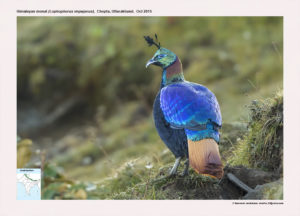
Himalayan Monal Lophophorus impejanus
Etymology:
- Lophophorus: Greek word lophos crest, tuft ; phoros -bearing
- Impejanus: Named after Lady Mary Impey (1749–1818), wife of Sir Elijah Impey (1732–1809) Chief justice of Bengal
Vernacular Names : NW Himalayas: Munal, Ghar munal, Ratia kawan, Ratnal, Ratkap, Kash: Sunal, (M) Suna murgh, (F) Ham, H.P.: Nilguru, Munal, (M) Nil, (F) Kareri, U.P.: Datiya, Mishmi: Pia padir, Dafe, Lepcha: Fo dong, Nepal: Dangan, Bhutan: Bup, Sikkim: Chamdong
Distribution in India: Resident of Himalayas in India
Description: Size of male 70–72 cm, wt. of male is 1980–2380 g; Size of female is 63–64 cm, wt. of female is 1800–2150 g. The male is iridescent green, copper and purple and has peculiar wiry crest and cinnamon-brown tail. It has chestnut wings and white rump/lower back. The female has plain streaking on underparts, a prominent white throat, short crest and bright blue orbital skin. The bill is greyish horn with enlarged and strongly decurved maxilla and yellowish-green legs. The male has single, small tarsal spur, female none. The first-year male is intermediate between adults of the two sexes, being larger than female, with variable number of black feathers on foreneck and metallic purple on upperparts. The juvenile is very similar to female but markings somewhat less distinct, while young males differ from young females in having some black spots on throat and a substantially darker-looking breast.
Habitat: It is found in open coniferous or mixed forests with rhododendron and bamboo understorey, in steep valleys; in and around cultivation, meadows and clearings. It roosts in trees. It is found from 2100m-4000m.
Food habits: It eats seeds, tubers, shoots, berries, insects and their larvae. It digs extensively with bill, creating distinctive dug-over areas on hillsides. It forages throughout day, in loose groups.
Breeding habits: Breeds in Apr to June in India and Bhutan. Breeding occurs at various altitudes from 2100m–4500 m. The courtship display involves male fanning tail, drooping wings and parading in front of female; also a flight display in which male glides with spread tail, the wings held above the body. The nest is a simple scrape under some bush, on a steep hillside and is often unlined. They lay a clutch of 3–5 eggs. The incubation period is 27 days.